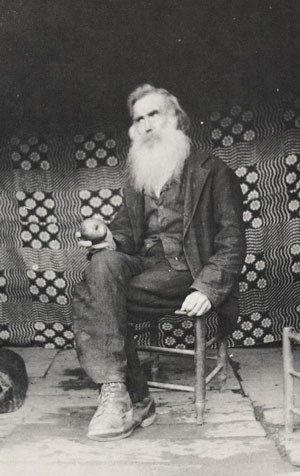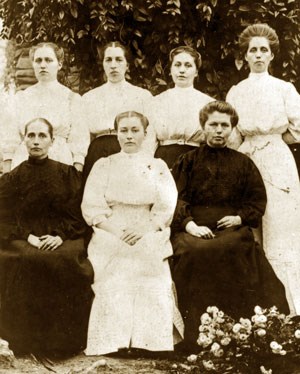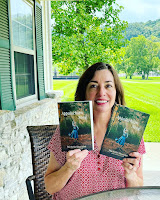One of the most fascinating tidbits in the park, however, has nothing to do with the beauty or the changing leaves. It has to do with a family named Walker who called these mountains home in the 1800s and 1900s. When the government came knocking on their cabin door in the 1930s, with plans to create a national park that included their property, well, let's just say the Walkers weren't too keen on the idea.
Let me tell you a little tale about a dream, a cabin, and some mysterious sisters...
 |
| John Walker, father of the Walker sisters |
During the Civil War, a young man named John Walker fought for the Union Army and was even captured and held prisoner. He survived, and after the war ended John married his sweetheart, Margaret Jane King, whose family came from Little Greenbrier, an area near present-day Gatlinburg, Tennessee. He purchased property from Margaret's father that already had a cabin on it, the original section built in the 1840s and the larger two-story section built by Mr. King in the 1850s. Being a very industrious man, John built a barn, corn crib, smokehouse, pig pen, apple barn, and blacksmith shop. A spring-house situated on a nearby creek kept dairy products such as milk and butter cool throughout the year, as well as provided storage room for pickled root vegetables. John was also a skilled carpenter and crafted ladderback chairs, looms, tools, and a small cotton gin. He planted orchards that included more than 20 kinds of apples, as well as peaches, cherries, and plums. Chickens, sheep, goats, and hogs were all raised on the farm.
In the midst of all this building and settling, Margaret gave birth to eleven children -- seven girls and four boys. All eleven children survived into adulthood, a feat not many families could boast back in those days. The boys grew up and left home, but only one sister--Sarah Caroline--married. The other six sisters remained unmarried "spinsters" and lived out their lives in their childhood mountain home.
 |
| The seven Walker Sisters: Front L-R: Margaret, Louisa, Polly. Back L-R: Hettie, Martha, Nancy, & Caroline. Photo: Jim Shelton, 1909 |
John Walker was 80 years old when he passed away in 1921. His six unmarried daughters, as well as his youngest son Giles, inherited the property. One of the sisters, Nancy, died ten years later, and Giles deeded his share over to his remaining sisters. For the next 43 years, the five Walker sisters would make a name for themselves in the community--and in the public's eye--as hardworking, if not odd, mountain women. Instead of looking to modern-day conveniences, they did all the farm work themselves, including tending livestock as well as a huge garden that provided their food for years. They raised sheep and washed, carded, spun, and wove the wool into clothing. Cotton and flax were also grown on the farm, and the sisters produced their own textiles using the cotton gin their father had built. Following in their mother Margaret's footsteps, the daughters also kept a herbal garden for mountain remedies, including horseradish, boneset, and peppermint for healing teas. Natural plants in the forests were collected, too. One of the sisters was quoted, saying, "Our land produces everything we need except sugar, soda, coffee, and salt."
 |
| Martha and Hettie on the porch; Louisa churning butter |
Living in the national park, however, meant their daily practices of hunting and fishing, cutting wood, and grazing livestock were now prohibited. The sisters were forced to find a new lifestyle in order to survive. People from all over the country flocked to the park and visited what became known as "Five Sisters Cove". The Walkers welcomed the curious newcomers and saw them as an opportunity to sell handmade items such as children's toys, crocheted doilies, fried apple pies, and even Louisa's hand-written poems.The sisters were even featured in the Saturday Evening Post in April 1946, showcasing their mountain lifestyle to the rest of the country.
 |
| The Walker Sisters Cabin (notice the stone steps are still there!) |
Over the next few years, the sisters began to die off. In 1951, with only two sisters remaining--Margaret, 80, and Louisa, 70-- they wrote a letter to the park superintendent asking that the "Visitors Welcome" sign be taken down. Margaret passed away in 1962 at the age of 92, and Louisa remained in the house alone until she died in July 1964.
Today, the homestead is a quiet place, tucked way back in the woods, a mile from the old Little Greenbrier school house that John Walker helped build in 1881. The old spring house greets you as you arrive, and I couldn't help but imagine all the butter, milk, and yummy garden goodies the sisters kept there over the years. John's corn crib is also still standing, and hubby and I were quite flummoxed over its design--no doors; only a small opening on the side to reach in and grab some corn that surely must have been loaded from a gap at the top of the far (covered) wall.
 |
| John's corn crib |
 |
| Old Little Greenbrier school house John helped build in 1881. The school house also housed a church, and a small fenced graveyard is off to the left. |
Your turn: Have you been to the Great Smoky Mountain National Park? What was your favorite part?
Michelle Shocklee is the author of several historical novels, including Count the Nights by Stars, winner of the 2023 Christianity Today Book Award, and Under the Tulip Tree, a Christy Awards and Selah Awards finalist. Her work has been included in numerous Chicken Soup for the Soul books, magazines, and blogs. Married to her college sweetheart and the mother of two grown sons, she makes her home in Tennessee, not far from the historical sites she writes about. Visit her online at www.MichelleShocklee.com
APPALACHIAN SONG
Forever within the memories of my heart.
Always remember, you are perfectly loved.
Bertie Jenkins has spent forty years serving as a midwife for her community in the Great Smoky Mountains of East Tennessee. Out of all the mothers she’s tended, none affects her more than the young teenager who shows up on her doorstep, injured, afraid, and expecting, one warm June day in 1943. As Bertie and her four sisters tenderly nurture Songbird back to health, the bond between the childless midwife and the motherless teen grows strong. But soon Songbird is forced to make a heartbreaking decision that will tear this little family apart.
Thirty years later, the day after his father’s funeral, Walker Wylie is stunned to learn he was adopted as an infant. The famous country singer enlists the help of adoption advocate Reese Chandler in the hopes of learning why he was abandoned by his birth parents. With the only clue he has in hand, Walker and Reese head deep into the Appalachian Mountains to track down Bertie Jenkins, the midwife who holds the secrets to Walker’s past.
https://www.tyndale.com/p/appalachian-song/9781496472441
APPALACHIAN SONG
Forever within the memories of my heart.
Always remember, you are perfectly loved.
Bertie Jenkins has spent forty years serving as a midwife for her community in the Great Smoky Mountains of East Tennessee. Out of all the mothers she’s tended, none affects her more than the young teenager who shows up on her doorstep, injured, afraid, and expecting, one warm June day in 1943. As Bertie and her four sisters tenderly nurture Songbird back to health, the bond between the childless midwife and the motherless teen grows strong. But soon Songbird is forced to make a heartbreaking decision that will tear this little family apart.
Thirty years later, the day after his father’s funeral, Walker Wylie is stunned to learn he was adopted as an infant. The famous country singer enlists the help of adoption advocate Reese Chandler in the hopes of learning why he was abandoned by his birth parents. With the only clue he has in hand, Walker and Reese head deep into the Appalachian Mountains to track down Bertie Jenkins, the midwife who holds the secrets to Walker’s past.
https://www.tyndale.com/p/appalachian-song/9781496472441





Wonderful post! I attended school in Jefferson City, TN (not far from Gatlinburg) and visited the park often. I don't remember hearing about the Walker sisters when I was there. Thanks for sharing.
ReplyDeleteI lived in Knoxville for 19 months and loved east Tennessee! Abram's Falls in Cades Cove was my go-to spot at non-crowded times of year.
ReplyDeleteLisa, "non-crowded" is the key! We were astounded at the crowds the weekend we were there.
DeleteI've never been there, but it seems like a beautiful place to visit. That's a great story about the Walkers!! Thanks for bringing it to our attention.
ReplyDeleteI'd never heard of these sisters before. What an interesting story!
ReplyDeleteI love this story of the Walker sisters! I live in MS, and the Smoky's are a favorite vacation spot for us as well as lots of our family and friends, esp. during the fall when the leaves are turning. I've never been to Five Sister's Cove, but will add it to my bucket list. Looks like the parks service is keeping the cabin and out buildings preserved. A shame for the buildings to fall into disrepair.
ReplyDeleteA favorite place is Cade's Cove and the hike to Abrams Falls (accessed through Cade's Cove). It's a slightly "challenging" hike with a 4 and 6 year old, though. lol
I love this, Michelle. What wonderful, interesting, eccentric, talented people. I wonder why they never married. There has to be a reason. My grandfather was from a family of nine and three of them married, and only ONE of the nine had children, though one of daughter who married adopted two children. I've always thought that was odd. My mom grew up around all those aging, cranky people who all lived in one house together. Dying off one by one.
ReplyDeleteI spend time daydreaming what went on in that house to make them all stay, all remain single.
And then the flip side, why did my grandpa married, then when his wife died in childbirth, marry again.
Seems weird and fascinating.
Mary, it truly does make one wonder why the sisters never married, but hopefully they had a very rich and full life.
DeleteI live in SC and have been to Gatlinburg at least once a year, every year of my life (50+ years). I have no idea what my favorite part is. I love it all. In fact, I've been looking recently into moving there.
ReplyDeleteHi everyone! I'm so happy you all enjoyed learning about the Walker Sisters! I highly recommend hiking to their cabin if you're ever in the area. It's such a pretty 1-mile-ish walk; not too difficult. We'll definitely go back! Have a blessed day, y'all!
ReplyDeleteI really enjoyed your story of the Walker sisters and their unusual life. This sounds like a story screaming to become a historical fiction novel. Perhaps you're the one to do it. I write a humorous historical fiction series, Mrs. Odboddy Hometown Patriot, set during WWII, here in California. Am wondering if this type of series is welcome at this website or only about more series elements of historical fiction? Thoughts? I'll join the group and keep an eye on the submissions.
ReplyDeleteI enjoyed this post very much! Yes, I've been to this area many times, but did not know this story at all. Gatlinburg and Pigeon Forge are my favorite areas there. I enjoy learning about the 'old days.' I LOVE reading mountain stories of long ago. My husband and I stayed at 3 Sisters Cabin in Virginia, which is a pre-civil war log cabin along the Blue Ridge Parkway. It is one of only a few still standing 2 story log cabins. That was an experience!
ReplyDelete